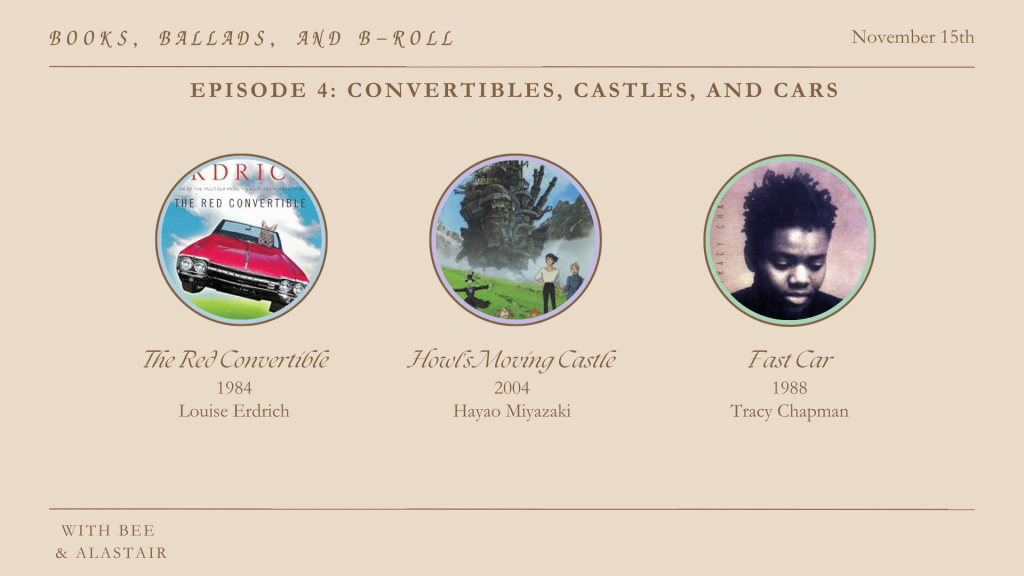Convertibles, Castles, and Cars

Hopewell Valley Student Podcasting Network
Books, Ballads, and B-Roll
Convertibles, Castles, and Cars
Episode #4
You are listening to Books, Ballads, and B-roll the podcast with your hosts Bee and Alastair.
In this episode of Books, Ballads, and B-Roll the podcast we discuss the role of transportation in different media.
Segment 1: The Red Convertible
The Red Convertible is a short story from Love Medicine, by Louis Erdrich. It’s narrated by a boy named Lyman and it revolves around his relationship with his older brother, Henry. The two are very close and bond over their shared red convertible, but when Henry returns from the Vietnam War, he is traumatized and closed off, something Lyman really struggles to understand.
- Bee suggests that the changing setting at the beginning of the story creates a freeing and adventurous feeling, which contrasts with the limited and claustrophobic setting after Henry returns from war. This movement from a setting that is a literal blur to a setting that is extremely limited is one way in which transportation, particularly the red convertible, is central to the story.
- Bee and Alastair discuss how the red convertible may represent the brothers’ relationship with one another or perhaps Henry himself.
- Bee and Alastair examine the symbolism of the red convertible’s fate.
Segment 2: Howl’s Moving Castle
Howl’s Moving Castle is, like in our previous episode, a movie by Studio Ghibli. Are we going to apologize for our perhaps over-heavy focus on Miyasaki films? No, no we are not. We will shamelessly defend Studio Ghibli’s status as one of the best animation studios out there. Although, actually, this movie is based on a book of the same name by renowned fantasy author Diana Wynne Jones—which we strongly recommend as well. The movie changes some aspects or focuses on different things from the book, but I think this is what allows it to be equally as good even though it’s not an original story. The book is almost always better than the movie in my opinion, but this may be an exception.
But anyway, the protagonist of Howl’s Moving Castle is Sophie, the eldest of three sisters and heiress to a hat shop. She feels resigned to a life of quiet drudgery and loneliness there, but then the feared Witch of the Waste comes to her shop in disguise. Sophie unknowingly stands up to the witch when the latter disapproves of her shop, and the witch casts a spell that turns her into an old lady. Sophie must leave home in search of a cure for the spell.
She somewhat accidentally finds herself taking shelter in the castle of a notorious wizard named Howl, who supposedly eats young women’s hearts. (There are a lot of supposedly scary witches and wizards in this movie. Most of them turn out less scary than they originally seem though!). In fact, Howl seems rather welcoming. The thing about his castle, though, is that it can walk! Powered by a fire demon, the gargantuan and rather impossibly proportioned structure walks around the landscape on thin metal legs. And not only that, but the castle is also magically split between four different locations, so while it’s walking around the prairie, it also occupies stationery shops in nearby towns.
- Alastair comments on the significance of the moving castle, especially in the context of war, as a way to shield the characters from various threats.
- Alastair acknowledges that the castle can also limit the characters and its ability to protect them from the outside world becomes a detriment.
- Alastair and Bee point out the various strange modes of transportation in this movie. Aside from the castle, each of the characters has a unique way of moving through the world–Turnip Head bounces, Howl can fly, Sophie must adjust to movement in her new elderly body, and Calcifer is unable to move on his own and has to be lifted.
Segment 3: Fast Car
Fast Car is a song by Tracy Chapman and I think it’s probably her best-known song in America. Fast Car is basically about a young couple and they both come from difficult backgrounds, or at least the narrator does. The narrator takes care of an alcoholic father after her mother leaves them, and also works a job as a checkout girl. The narrator dreams of escaping this environment in her lover’s fast car for a better life in the suburbs, but when this dream is finally achieved it’s also shattered. She creates a better life for both of them where she makes enough money to pay the bills, but the person she’s singing about ends up spending most of their time at the bar and neglecting the family they’ve built.
- Bee questions who the song might be about and notes possible factors in Tracy Chapman’s life that may have inspired her writing.
- Bee notes the sense of longing and nostalgia this song evokes and suggests the car represents hope of escaping cycles of poverty. It also symbolizes the illusion of the American dream, similar to the car in The Great Gatsby.
- Alastair draws a connection between Fast Car and the other transportation-themed media, noting how methods of transportation are used as a means of freedom and escape, which prove to be ultimately unsuccessful.
- Bee offers a personal anecdote about her mom’s love for this song, and a sweet memory with her cousins she always associates with it.
Music Credits:
- Flowers and Weeds (Acoustic Guitar & Penny Whistle) by Axletree
- Marty Gots a Plan by Kevin MacLeod

